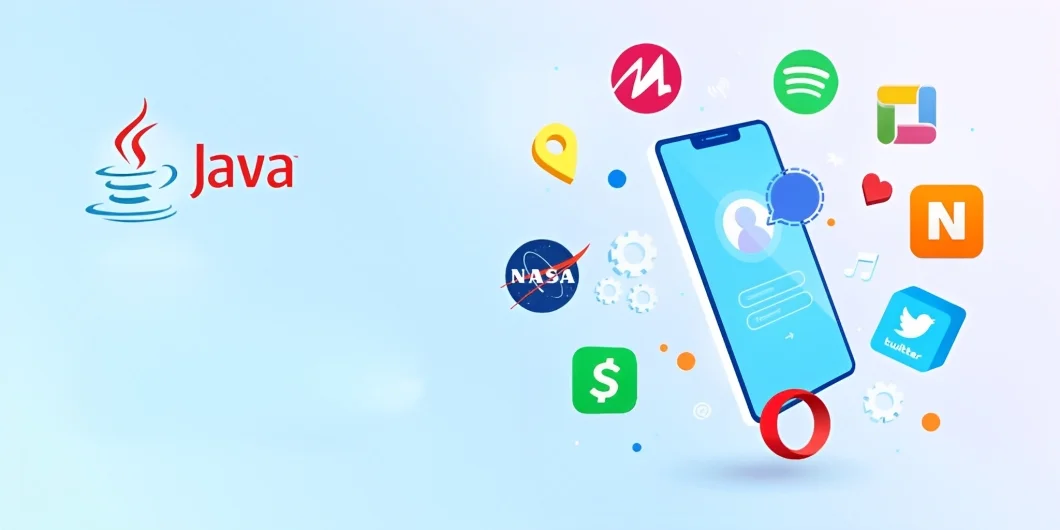How I Used Java to Create a Mobile App for My Business
Your company’s reach and client interaction can be greatly increased by having a mobile app in the modern digital world. The flexible programming language Java provides a strong framework for building effective, scalable, and user-friendly mobile applications.
Java mobile app development is a calculated step that has several advantages for your company. You can build a mobile app that stands out from the competition and provides a flawless experience for your users by utilizing the power of Java. To get the most out of your experience developing mobile apps, let’s look at some extra insights and advice.

Understanding the Power of Mobile Apps
It is important to understand the benefits that mobile apps offer organizations before starting the development process. Mobile apps offer a direct line of connection with consumers, allow for personalized experiences, streamline transactions, and promote brand identification and loyalty.
Choosing Java for Mobile App Development
Java is a great option for creating mobile apps because of its widespread library support and platform neutrality. It is a recommended language for developing adaptable apps across many platforms, including Android, because of its object-oriented architecture, strong security features, and large developer community.
Setting Up the Development Environment
Setting up the required development environment is crucial before starting the Java mobile app development process. Installing JDK, Android Studio, and setting up the necessary dependencies are all required for this.
Defining App Requirements and Architecture
It is essential to establish the specifications and architecture of the mobile app before beginning any coding. This entails figuring out who the app is intended for, describing its features and functionalities, and creating a user-friendly interface. A clear plan guarantees a successful development process and a finished product.
Implementing Core Functionality
The fundamental operations of the mobile app can be implemented using Java and the Android SDK. Manage different app capabilities like user authentication, data extraction from APIs, real-time updates, and more, this entails building code for activities, fragments, and services. Java’s best practices and design patterns guarantee scalable and maintainable programming.
Integrating Third-Party APIs and Services
Integrating third-party APIs and services can greatly improve the functionality of the mobile app. Java offers top-notch assistance for incorporating APIs for social media networks, payment processors, mapping applications, and more. The user experience is improved by these linkages, which allow for seamless interactions with external systems.
Testing and Debugging
Thorough testing and debugging are necessary to guarantee a high-quality mobile app. To find and fix any flaws or performance issues, a variety of testing methodologies should be used, such as unit testing, integration testing, and user acceptance testing. The testing process can be automated with the help of Java’s testing frameworks, such as JUnit, to guarantee dependable program behavior.
Optimising Performance and User Experience
For the mobile app to be successful, performance and user experience must be optimized. Java offers strategies and tools to improve the speed of apps, including memory management, effective data handling, and network optimization. The user experience can also be greatly enhanced by using responsive layouts, fluid animations, and intuitive design principles.
Deploying the Mobile App
When the mobile app has finished being developed and tested, it is time to launch it. Java makes it simple to package and distribute the program, making it available for consumers to download and install through app stores like the Google Play Store. Techniques for optimizing an app’s exposure and downloads in the app store, such as keyword optimization and compelling app descriptions can help.
Post-Launch Maintenance and Updates
The mobile app’s debut is just the start. To keep the app current, safe, and in line with evolving user needs and technical improvements, regular upkeep and upgrades are necessary. The long-term viability of the app depends on consistently tracking user feedback, responding to problem reports, and adding new features or improving existing ones based on market trends.
Monitoring Analytics and Gathering Insights
Monitoring your mobile app’s performance and gathering insightful data is essential once it has gone live. Utilizing analytics software, such as Google Analytics or Firebase Analytics, enables you to monitor user behavior, calculate important data, and spot potential improvement areas. You may make data-driven decisions to improve user engagement, optimize features, and promote business success by analyzing this data.
Encouraging User Feedback and Reviews
Your mobile app can greatly benefit from user feedback. Actively solicit user feedback and reviews through in-app prompts or specific ways of receiving them. Pay attention to their requests for features, issue reports, and ideas. This feedback loop encourages participation, enables rapid problem-solving, and demonstrates your dedication to providing an excellent customer experience.
Implementing App Store Optimisation (ASO) Techniques
App Store Optimisation (ASO) strategies must be used if you want to guarantee that your mobile app appears higher in app store search results. To identify the search terms relevant to the market for your app, conduct in-depth keyword research. Include these keywords naturally in your app’s title, description, and metadata. Users may also be persuaded to download your app by an appealing app icon, intriguing pictures, and an enticing app description.
Embracing Regular Updates and Feature Enhancements
Regular updates and feature improvements are essential for keeping your mobile app competitive and meeting changing user expectations. Continually acquire customer input, keep an eye on market trends, and pinpoint areas that need improvement. Through routine updates, you can add new features, enhance existing functionalities, and fix any bugs or performance problems. This iterative strategy shows your dedication to offering a first-rate user experience.
Optimizing for Speed and Performance
Customers have little patience for slow-loading apps in the fast-paced digital world of today. Therefore, it is crucial to optimize your mobile app for speed and functionality. Java provides several methods to enhance app speed, including memory consumption optimization, caching implementation, and reducing network queries. To provide a seamless and responsive user experience, carry out rigorous performance testing and optimization.
Implementing Robust Security Measures
When creating a mobile app, security should be given top consideration. To safeguard user data and stop unauthorized access, Java has strong security features and best practices. Implement safe authentication procedures, encrypt confidential information, and adhere to accepted security standards. Update your app’s security settings frequently to remain on top of emerging dangers and ensure your users’ data is secure.
Leveraging Social Media and Influencer Marketing
Your mobile app’s visibility and user acquisition can be dramatically increased by marketing it via social media and influencers. Create interesting content about the focus of your app, distribute updates, and invite users to follow and share your postings. Your reach can be increased, and you can draw in the right user base by working with influencers or industry leaders to promote your app.
Building a Strong User Community
By adding forums, message boards, or in-app chat tools, you may help your app’s users feel more connected to one another. Encourage users to interact, exchange stories, and support one another. You can increase user engagement and develop a devoted user base that promotes your app and aids in its expansion by creating a strong user community.
Monitoring and Responding to App Reviews
App reviews are essential to influencing how people view your mobile app. Follow up on app evaluations across various platforms regularly. Express gratitude for favorable reviews and respond to any issues or concerns mentioned in bad reviews. This proactive approach shows your commitment to customer happiness and can help your software keep a good reputation.
Staying Updated with Java and Mobile App Trends
To keep your app competitive, it is crucial to keep up with the most recent Java and mobile app development developments. Java frequently releases updates and new capabilities, so keeping up with these developments allows you to take full advantage of them. Additionally, keeping an eye on user preferences, industry developments, and upcoming mobile app trends will enable you to add cutting-edge features and stay ahead of the curve.
Emphasizing User-Centric Design
For your mobile app to connect with your target audience, you must utilize a user-centric design strategy. Spend time learning about the preferences, habits, and problems of your users. Create a user interface (UI) that is simple, easy to use, and has elements that are obvious calls to action. To guarantee that the app offers a flawless and pleasurable user experience, do user testing and gather feedback during the design phase.
Utilizing Push Notifications for Engagement
Push notifications have the potential to be an effective tool for interacting with app users. By implementing a well-thought-out push notification system, you may send users’ devices customized messages, updates, and deals. When using this function, be careful to add value by informing users of new features, special offers, or interesting material. To keep users engaged without tiring them out, try to strike a balance between timely and pertinent messages.
Integrating Social Sharing Functionality
Your mobile app’s reach and virality can be increased by adding social sharing capabilities. Give users the ability to quickly share content, accomplishments, or app-related updates on well-known social media sites. Through word-of-mouth advertising, this not only aids in growing your user base but also improves brand recognition and encourages user interaction.
Implementing App Analytics for Insights
App analytics implementation is crucial if you want to understand your app’s performance and user behavior more thoroughly. Analytics solutions like Flurry and Firebase Analytics offer useful information on user demographics, session length, popular app features, and other topics. Utilize these insights to enhance your marketing tactics, make informed choices, and continuously enhance the functionality and user experience of the app.
Incorporating Gamification Elements
Gamification components can increase user engagement and encourage them to stay in your mobile app longer. Consider including tools that recognize users for doing tasks or reaching milestones, such as badges, points, levels, or leaderboards. Users are motivated to stay active and devoted to your app by the sense of fun, competitiveness, and accomplishment added by this gamified experience.
A/B Testing for Optimisation
You can test many iterations of your app’s design, functionality, or messaging to see which is most successful by using A/B testing. To determine user preferences and improve the functionality of the app, experiment with alternative elements such as button positions, color schemes, or even different functionalities. Gather user input, examine stats, and decide which version performs better. Then, iterate according to your findings.
Providing Excellent Customer Support
Providing dependable customer service is essential for preserving user pleasure and resolving any problems users may experience. Give users a variety of ways to contact you, such as in-app chat, email, or a specific help portal. When a user asks a question or complains, respond quickly and sympathetically. This will help you give great customer service and practical answers. A satisfying support experience can have a big impact on users’ perceptions and help keep them coming back.
Localizing the App for Global Reach
Examining app localization is crucial if you want to reach a global audience. To guarantee that it appeals to users from various locations, localize the content of your app, taking into account the language, currency, date formats, and cultural quirks. This indicates your dedication to meeting their unique needs and tastes, thereby enhancing the global reach and attractiveness of your software.
Continuous Iteration and Improvement
Iteration and enhancement are continuous processes in the creation of mobile apps. Continually adapt to customer input, market trends, and technological developments. Release updates frequently to fix errors, add new features, and improve current functionalities. You can provide an outstanding user experience and keep a competitive edge in the market by constantly iterating and upgrading your app.
Conclusion
In today’s cutthroat business environment, creating a mobile app with Java can be a game-changer. The resilience, adaptability, and wide-ranging community support of Java make it the perfect platform for producing top-notch mobile applications. You can construct a mobile app that not only expands the reach of your company but also offers a seamless and enjoyable experience for your consumers by adhering to a methodical development approach, integrating necessary functionality, optimizing performance, and placing a priority on user experience. Accept the power of Java and set out on your path to developing a successful mobile app.


